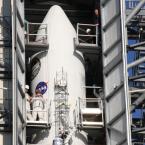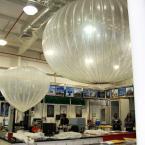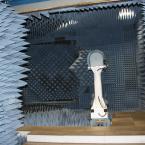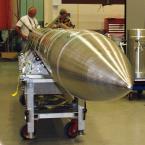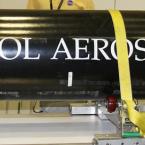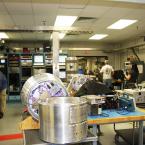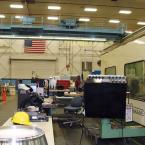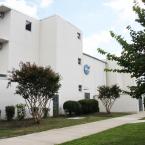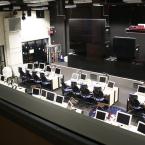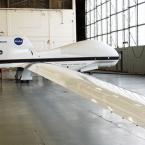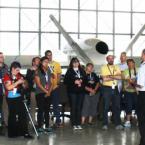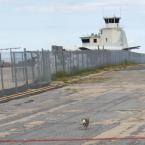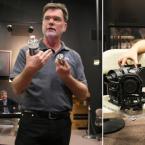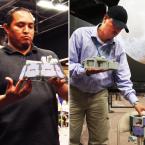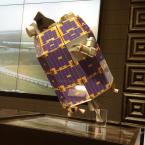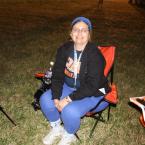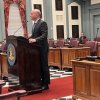Sharing the mission at Wallops Island
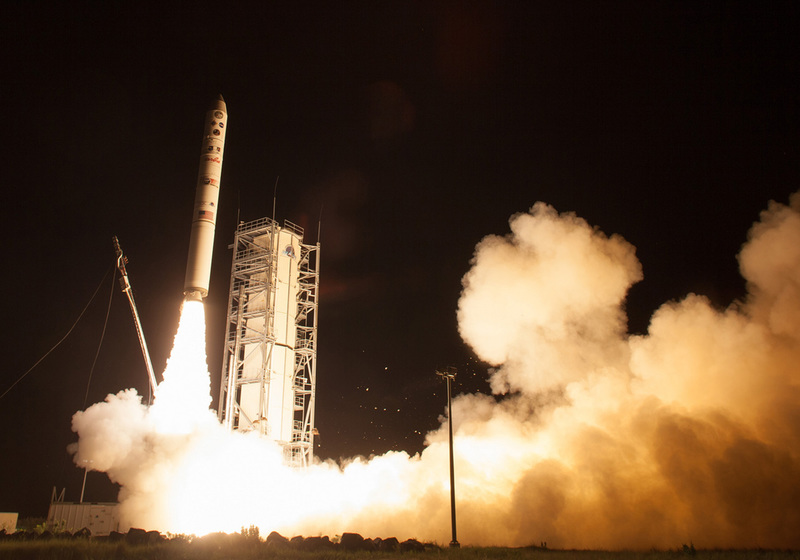
NASA invited 50 of its social media followers to a special event September 5 and 6, at the Wallops Flight Facility, Va., for the launch of the Lunar Atmosphere and Dust Environment Explorer (LADEE).
During the event, called a NASA Social, attendees were given the opportunity to go behind the scenes at NASA facilities and events and speak with scientists, engineers, astronauts and managers.
The occasion marked the 71st in-person NASA social media event since 2009 and the second one held at that facility since 2011. They were originally called Tweetups.
“If you aren’t a space geek now, come on out to a NASA Social. We’ll make sure you go home a space geek, that’s for sure,” said Jason Townsend, NASA’s deputy social media manager.
The Wallops Island Flight Facility is located roughly an hour and a half south of the Cape Region, a few minutes west of Chincoteague.
Access to the base is usually restricted, but the visitor center across the road is open to anyone. Admission is free.
The invitation to the Social was announced over Twitter and Facebook. Available spots filled up fast.
Our group consisted of space enthusiasts from as far away as Portland, Oregon and as close as Chincoteague itself. We had students, teachers, engineers, aspiring astronauts, designers and more. Being part of such a large group with the same passion for the space program created an instant camaraderie.
We were all armed with multiple electronic devices - cameras, cell phones, laptops and tablets. During one of the bus trips, someone quipped, “This is the first time I’ve traveled with people who carried as much equipment as me. I don’t have to apologize.”
The two days were spent attending pre-launch and science briefings, visiting the launch pad where the Minotaur V rocket carrying the LADEE probe sat, and touring the main base, with stops at the Balloon Facility, Sounding Rocket Facility, Range Control Center and Global Hawk hangar.
Friday night, the group enjoyed a visit by NASA Administrator Charles Bolden, who offered many inspirational words on the importance of space research to daily life technology, education and international cooperation.
The group was then bussed to a special viewing area, where we witnessed Wallops Island’s first deep space launch.
LADEE
LADEE (pronounced “laddie”) is designed to study the Moon’s thin atmosphere and lunar dust environment.
Contrary to what most of us may have learned in school, the Moon really does have an atmosphere. It is called an exosphere, an extremely thin layer of molecules that do not interact as they do in the lower atmosphere of Earth. It is most common type of atmosphere we have in our Solar System. Mercury, many moons of other planets and even some larger asteroids have exospheres of this type.
“One of the cool things about LADEE,” said Program Scientist Sarah Noble, “is that we’re not only going to learn about the Moon when we go there, but we’re going to learn about this whole class of atmosphere, which is something we don’t know a lot about right now. It’s sort of a great opportunity to go to someplace that’s nearby and easy to get to and we can learn about the entire solar system from just studying in our local neighborhood.”
A strange glow on the horizon has been reported from past surveyor landers and the Apollo astronauts. Noble explained that one of LADEE’s goals is to study lunar dust to try to explain this phenomenon.
Innovative technology will also be tested, including a modular spacecraft design and a new high-rate laser communication system. This type of system uses laser beams to transmit larger amounts of data similar to how high-speed fiber optic networks function on Earth.
After it reaches the moon, LADEE will begin its 100-day science mission, at the conclusion of which it will be deliberately crashed onto the moon's surface in such a way that it can be observed on Earth. The limited fuel reserves aboard the probe would make it impossible to maintain an orbit in the fluctuating gravity field.
LADEE is the first space spacecraft built, tested, integrated, designed, developed completely by NASA-Ames Research Center, in California’s Silicon Valley. Learn more at nasa.gov/ladee.
Minotaur V
LADEE was carried by the Minotaur V, a five-stage expendable launch system derived in part from a former Peacekeeper or MX missile, and designed to place a payload in Earth orbit.
The rocket is part of the Minotaur series developed by Orbital Sciences of Dulles, Va. Orbital develops and manufactures small- and medium-class rockets and space systems for commercial, military and civil government customers.
This is just one of many private companies which is entering what NASA Administrator Charles Bolden calls the corporate space race. Visit Orbital Sciences at www.orbital.com.
Lou Amorosi, Vice President of orbital and suborbital programs at Orbital Sciences, explained that the reason they were launching with a payload the first time out was that most of the components had already been tested on Minotaur IV rockets, and with the limited amount of missiles of that type available, it was the most cost-effective course.
First briefing
The first guest introduced at the first briefing Thursday morning was John Grunsfeld, Associate Administrator of NASA’s Science Mission Directorate in Washington, DC. He is an astronaut and veteran of five shuttle missions, during which he visited the Hubble telescope three times.
During the question/answer portion, Grunsfeld recalled his first shuttle mission on Endeavor, in which the crew was convinced the launch was going to be scrubbed.
“Turns out a big hole had opened up in the clouds that we couldn’t see,” he explained. “So there was really no time to get nervous. 6 seconds or so before launch, the main engines started and the vehicle really came alive. You could feel resonances and waves traveling up and down the vehicle. You could really feel what’s called the twang, because we’re up in the cabin which is far away from the hold-down posts, so you really feel the vehicle [moving] and as it came back to vertical, sure enough, the solid rocket lit off and then it felt like a train wreck. It felt like you’re in a car and someone hit you from behind in a big truck, because the shuttle really leaps off the pad.”
In addition to John Grunsfeld, Sarah Noble and Lou Amorosi, three other speakers were featured.
Bob Barber from NASA-Ames, spoke about the modular design of the LADEE probe and how all modules are created with a single mold. These different modules can be combined to create different types of structures. Barber also explained the individual instruments on the craft.
Sarah Daugherty is the test director for the LADEE mission. Her job is to confirm readiness by all teams prior to launch.
In answer to a question about controlling the carbon footprint, Daugherty said that there is an environmental office at the facility filled with biologists, chemists and engineers that review all missions and look at the impact on the environment. Their job is to maintain a symbiotic relationship with the marshlands, wetlands and the species that live there, to make sure that the facility’s work is not impacting them.
Brian Day is the Public Outreach lead for NASA-Ames. Day discussed how the students in classrooms across the country and around the world through a program called the Goldstone Apple Valley Radio Telescope (GAVRT) program. They will be able to monitor and track the spacecraft and do basic exercises in orbital dynamics once it is around the moon. Participants can be aware of spacecraft functions before mission teams. Amateur astronomers can play a key role in this mission by reporting the flash of meteor impacts on the moon’s surface as seen through 8 to 14-inch telescopes. These impacts may be a major source of the moon’s atmosphere. NASA is looking to create a network of observers around the world to collect this impact data. Even meteor activity in the Earth’s atmosphere as seen with the naked eye can provide a clue about what’s happening on the surface of the moon. An app for iPhone and Android called Meteor Counter is available to record the observed information. Find out more at deepspace.jpl.nasa.gov/dsn/gavrt.
MARS and the launch pad
The day proceeded with a look at the National Oceanic and Atmospheric Administration (NOAA)’s Science on a Sphere (SOS), a room-sized, global system at the Visitor Center that displays planetary data via video onto a six-foot diameter sphere. This system is an educational tool that visually explains processes on the Earth and the Moon.
After a lunch break we attended pre-launch and science briefings that delved more into what to expect at the launch, and what was hoped to gain from the experiments that will be done. Then, we went to MARS.
The Mid-Atlantic Regional Spaceport (MARS) is a commercial space launch facility at Wallops on land leased from NASA. The Antares missions which will be used to resupply the International Space Station will launch from one of its pads. Minotaur V was set to launch from the other pad.
“How many of you have brains that have turned to mush?” asked Townsend, on the way to the Spaceport. Hands were raised throughout the bus. We had absorbed more information than some of us are used to processing. I wasn’t sure if I still remembered my home address, but I could tell you all about the star-tracking system aboard LADEE.
When we reached the launch pad, the rocket’s gantry doors were closed. Before we got off the bus, we were asked to leave all devices except cameras on the bus. There was a concern that a stray signal could set something off before schedule. But, then it was determined that airplane mode on the cell phones was fine.
We spend the time taking pictures, chatting with the Orbital Sciences employees on the other side of the tape. Beyond the gantry was the sea wall and the ocean.
Eventually the doors were opened and we were able to see the 80-foot rocket that would carry LADEE up into the atmosphere. We waved and cheered at the workers on the railing at the top of the gantry. They waved back and took photos. We took our group photo after they closed the doors.
Wildlife was certainly present. In addition to fat dragonflies and the occasional colorful spider on someone’s shoulder, on the way out of the Spaceport we saw a white-tailed deer on the side of the road.
Since the Spaceport has been set up with funding from federal and state government, as well as investments from private companies like Orbital Sciences, the future looks bright for space research and development based on that area of the Delmarva Peninsula, according to Wallops Facility Director Bill Wrobel.
Balloons, Rockets and Hawks
On Friday - Launch Day - the first item on the agenda was a trip through the guts of the operation, where I’d been itching to go since my first visit to Wallops Island.
Since it was almost noon, our bus dropped us off at the very reasonably priced Wallops cafeteria for lunch. The base exchange (gift shop) was the next stop for some.
Then, off to the Balloon Facility.
We were greeted by an enthusiastic Denise Gramlich, secretary at the facility. She mentioned that many highly placed members of the NASA organization got their start in scientific balloons.
“We put these balloons up and we get them back safely. You get your payloads back,” she said, referring to the equipment attached to the balloon. “That’s an important thing. Because you get to work on them, you get to make them bigger, you get to make them better and you get to fly them again.”
The NASA Balloon Program provides high altitude scientific balloon platforms for scientific and technological investigations, including discoveries that contribute to our understanding of the Earth and the solar system. Scientific balloons also provide a way to develop new instrument and spacecraft technologies for NASA’s science missions. Some of these balloons can inflate to the size of the Astrodome. More information about the Balloon Program can be found at sites.wff.nasa.gov/code820.
The Sounding Rocket Facility was, in a word, huge. Selfies were being snapped all around the Black Brant V rocket we encountered shortly after entering the building. Sounding rockets are instrument-carrying rockets that take measurements and perform scientific experiments during sub-orbital flights. They access areas above balloons but not as high as satellites. They can be used to test equipment for more complicated orbital spaceflight missions.
After the “rocket room,” we were led by Cathy Hesh through the integration area, where the experiments are joined with their rockets. Beyond that was the machine shop, as big as an airplane hangar, where the rocket parts are constructed. Here, we had to wear safety goggles until we came out the back door. More information on the Sounding Rocket Program is available at sites.wff.nasa.gov/code810.
The next building we invaded contained the Range Control Center. An elevator trip up and we were peering through the glass above the Wallops Integrated Control Center room that will house all the people in charge of getting LADEE and Minotaur V off the ground at launch time.
The last stop was a visit to see the two Northrop Grumman Global Hawks, unmanned surveillance aircraft, now used to explore status and formation of tropical storms and hurricanes. They resembled something out of Star Wars, with their massive wingspan and sleek design. Mission lead scientist Scott Braun stopped to speak with us about the Hawks’ missions and functionality. Visit airbornescience.nasa.gov/aircraft/Global_Hawk to learn more.
SOS pop-in speakers
Back at the Visitor Center, we were placed in the SOS room once more to await several more speakers including, but not limited to, John Grunsfeld, Apollo program veteran Dick Hodges, the hosts of the online show NASA Edge, Deputy Chief Technologist for NASA Jim Adams and Don Cornwell, mission manager for the Lunar Laser Communications Demonstration at NASA-Goddard.
Jim Adams spoke about how NASA research spins off into commercial products here on Earth. He mentioned an available app that profiles this transition called NASA Spinoff. Find it at www.nasa.gov/connect/apps.html.
We also had two visitors from Navaho Technical University - intern Jaron Edsitty and CAD instructor Gregory Dodge. They brought a lovely 3-D printed model of the LADEE probe created by Edsitty. The university is a tribally controlled postsecondary career and technical institution in Crownpoint, New Mexico.
A word from the Administrator
After our dinner break, we reconvened at the Visitor Center auditorium for a special guest speaker, who turned out to be none other than NASA Administrator Charles Bolden.
Bolden is an astronaut veteran of four space flights during the shuttle program. He has helmed the National Aeronautics and Space Administration since 2009.
An engaging and personable speaker, he had us hooked from the beginning, when he gave group member and teacher Kimberly Alix a hug in response to a note she had sent him expressing the importance of NASA research in education and everyday life.
On NASA Socials: “We found right away that they were like magic. Because, instead of us reaching 300 people who came to a launch, or maybe a few thousand people who could watch on NASA TV, we were now reaching literally millions of people around the world. So, that’s what you do. You are the eyes and ears of people around the world with whom you communicate. And so, my advice to you if you haven’t done this before - be yourself.”
On asteroids: “We really need to go back to the moon, but right now the path that we’re on [with humans] is first an asteroid by 2025 with our asteroid retrieval mission, which is doing something that’s never been done before. If we’re successful - and we find that we can manage to maneuver an asteroid into lunar orbit, and then later bring a crew up so that we can have astronauts interact with the asteroid - guess what we’ve demonstrated? That we can deter or we can deflect an asteroid that’s inbound to Earth. I’m not a ‘save the planet’ person. That’s not our job. But, our job is to develop the technology that we can make available to the national command authority so they can decide when we find that there is an Earth-threatening asteroid, that we can do something other than sit there and watch, and pray.”
On teachers: “My wife’s mom and dad were teachers and then principals. My mother was a librarian...middle school. I’m saying all this to say I watched them, growing up. And I thought about being a teacher and I said no way! They work too hard, they make too little. And back then, they were appreciated, when I was growing up, unlike today. And I just can’t do that. So, I honor you all for what you do, I appreciate it. I mean, you’re who makes us what we are.”
On the way space exploration can bring nations together: “Two things, I tell you, that were the crowning achievements of the space station and the shuttle programs, and they’re not technical. The crowning achievement of the space shuttle program, which was a phenomenal 30 years is that it brought us diversity to the space program that we had never seen before. We opened up the opportunity to fly to people from all walks of life. What the International Space Station has done is that it has brought peace and prosperity to a significant number of nations of the world that, prior to that, wouldn’t even talk to each other. And some still don’t talk to each other down here on Earth. But, it has represented a way for nations to come together for a common cause, work collaboratively through problems and come to decisions where you compromise. If we can do it in space, we can do it back down here on Earth.”
Listen to the whole conversation at the video link above.
5...4...3...2...1...
Friday afternoon had everyone worried.
A bank of clouds had moved into what were previously beautiful blue skies. At the very least, cloud cover would disrupt visibility. Or it could halt the launch altogether.
At the SOS room in the Visitor Center, John Grunsfeld said that according to online weather sites, the only place where there were clouds was directly over the Chincoteague/Wallops Island area. He seemed optimistic that they would blow through by later tonight, though.
He was right.
As we left the Visitor Center to ride the bus to the viewing site, the sky was clear. At the viewing site, just two miles from the launch pad, it was a star-watcher’s delight. All we had to hope for now was that everything went well with the tech.
By 10:30 p.m., it was getting chilly. Our excitement kept us warm, as well as multiple layers of clothing and the occasional borrowed towel.
We had been advised that we should put down the cameras and just enjoy the launch. I was happy to comply. Although my borrowed digital SLR was adequate for this type of assignment, I was not so confident in my photography skills, especially without a tripod. I would share NASA’s public domain images to cover this portion. Others set up their equipment as best they could to get images and video, some with two or three different cameras and tripods.
The countdown was like that of a New Year’s Eve party. We could hear the checklist being announced by the Control Center. Cheers went up at the 1 minute announcement. We were all firmly planted at our stations.
Everyone joined into the countdown during the last five seconds. Then the bottom of the Minotaur burst like a struck match. Happy screams let loose.
There was a dome of light over the launch pad as if someone had flipped a switch and turned on morning. This is something you never see on video.
Something else that was surprising was the color of the exhaust as the Minotaur rose into the air. It wasn’t white as shown in photographs, but orangey red, like a pulsating fox tail.
After a few seconds, the roar of the engines reached us and the cheers exploded again. We also started to feel the vibrations coming from the ignition.
The rocket sped away, turning into a glowing ball, with sparks flying. More whoops at the lighting up of the second and third stage separations. It was soon announced that vehicle was over Bermuda. The glowing ball was now a disappearing speck and we could hear the buses behind us turn on their engines.
High-fives all around.
The after-glow
The bus ride back to the Visitor Center was slow due to traffic congestion. A waning wi-fi signal was delaying everyone’s uploads. Even tweeting became a bit difficult for some.
John Pritchard of Leonardo, NJ, referred to the excited conversations amongst ourselves as “tweeting out loud.”
At the Center, a few of us diehards stayed to wait for the 2 a.m. press conference.
“Launching a rocket is hard,” said John Grunsfeld. “And there’s so many things that we control that tonight just went spectacularly well.”
That said it all.
In the days that followed, there was inevitably a sense of withdrawal. Two days had seemed like two months. The return to “normal life” was almost strange.
During the Social, we learned a lot about the science, but most importantly, we were given a chance to see the faces behind it all - the men and women who work day-to-day in this revolutionary industry, which is no longer limited to a few government agencies. It is expanding into all our lives through private enterprise, creating jobs and technology that will affect future generations.
Find out when the next NASA Socials are taking place at www.nasa.gov/connect/social.














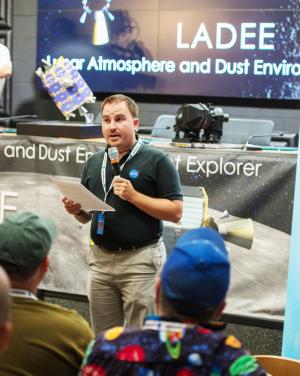
![Astronaut Dr. John Grunsfeld, Associate Administrator of NASA’s Science Mission Directorate in Washington, DC, addresses the group with some personal history and stories from his time as a veteran of five shuttle missions, during which he visited the Hubble telescope three times. “I didn’t get the go to the moon or to Mars," he said. "I know that young people today can aspire to that. I just want to remind everyone that LADEE, Curiousity [rover] on Mars - they’re robots. They don’t discover things, people do.” BY TERESA RODRIGUEZ](/sites/capegazette/local/styles/gallery_large/public/2013/09/field/gallery_large/John%20Grunsfeld.jpg?itok=7Oih75I6)
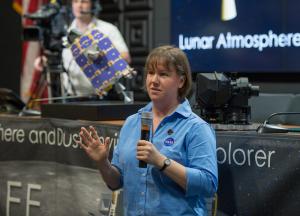
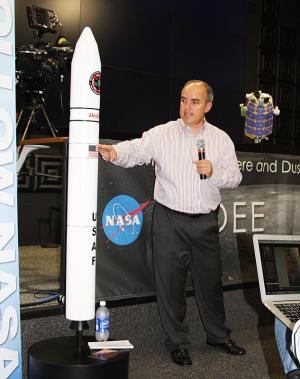
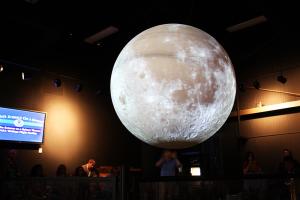
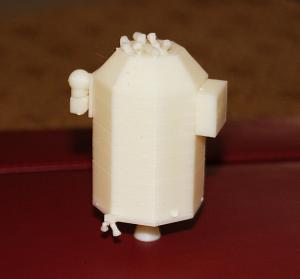
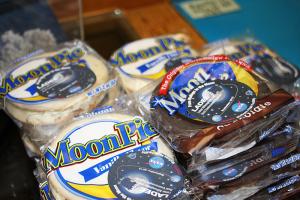
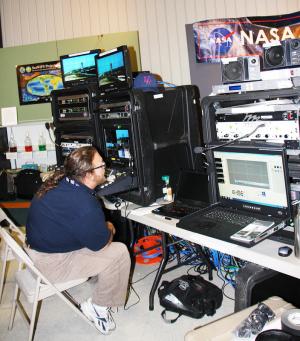
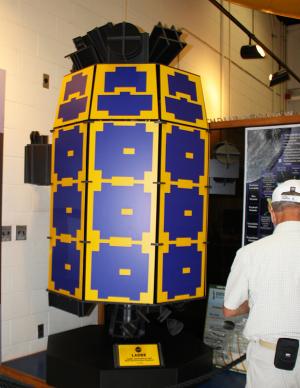
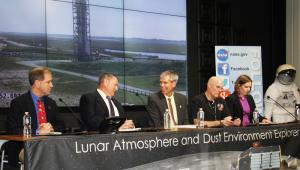
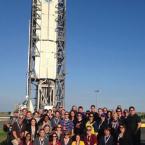
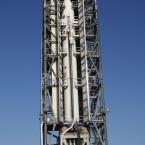
![Jack Thompson, shown in front of the Minotaur V, is the Director of Communications for the Penn State Lunar Lion X Prize Team and a sophomore student at the Pennsylvania State University. The Google Lunar X Prize competition challenges private companies to land a spacecraft on the Moon by 2015. "The team as a whole gained a lot from the launch," said Jack. "We gained many media contacts and were able to further spread our name in the space community by communicating with other participants of the NASASocial, some members of the public, as well as the media in general. [The launch] gave me some much needed preparation for the launch of our own spacecraft in 2015. This was an extremely exciting event." Follow the journey of Lunar Lion at lunarlion.psu.edu. BY COURTESY OF JACK THOMPSON/LUNAR LION](/sites/capegazette/local/styles/gallery_small/public/2013/09/field/gallery_small/Jack_Thompson_Lunar_Lion.jpg?itok=biA6OY4T)
